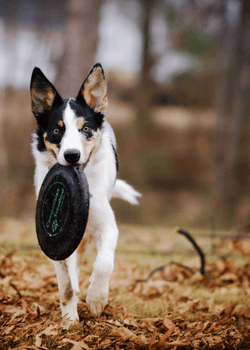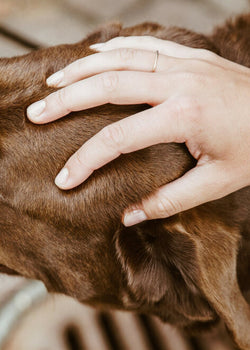Allergies in dogs
Allergies in dogs are very common, even more so. Although we cannot explain exactly why they are increasingly common in our pets, inadequate diet and lifestyle are attributed as the main causes.
Does your puppy scratch, have red skin or is he constantly licking a certain area, regardless of how well you take care of his basic care ? Have you thought that your dog has an allergy?

If that's the case, then you've probably figured out by now that dog allergies aren't as simple as you might think. To begin with, it is good to know that there are several types of allergies that can cause discomfort to your dog.
Symptoms of allergies in dogs
Symptoms of allergies in dogs can vary depending on the cause. However, in the beginning, it is important to recognize them and act accordingly.
The most typical and common signs that our dog has an allergy are:
- Pruritus (itchy skin)
- Hives (rash)
- Swelling of the face, ears, lips or eyelids
- Red, inflamed skin
- Diarrhea
- Vomiting
- Sneezing
- Itchy ears
- Chronic ear infection
- Itchy, 'cold' eyes
- Constant licking
Of course, we must be aware that these symptoms can also be signs of other problems. It is precisely for this reason that it is best to discuss the signs with a veterinarian , who will help you determine an accurate diagnosis, as this will help your pet to feel better.

In the first place, of course, the most important thing is to discover the problem that causes certain symptoms. Only in this way will you be able to treat the disease and not just its symptoms.
However, since it is necessary to realize that it is very difficult to completely avoid certain allergens and because certain disease states are eliminated for a long time, it is of course also necessary to take care of alleviating the resulting symptoms and problems .
Types of allergies in dogs
Allergies are a hypersensitive reaction of the immune system to a certain substance (allergen), which naturally can affect both humans and our pets.
There are quite a few different types of allergies in dogs. Skin allergies, food allergies, and environmental allergens present challenges for dogs and their owners, and what can cause us even more headaches in identifying and preventing allergies is that the symptoms of all these different types of allergies can overlap.
Skin allergies
Skin allergies, called allergic dermatitis, are the most common type of allergic reaction in dogs. There are three main causes of skin allergies in dogs:
-
Allergic flea dermatitis is an allergic reaction to a flea bite. Some dogs are allergic to flea saliva and this makes affected dogs very itchy, especially at the base of the tail, and their skin can become red, inflamed and scabbed over.

-
Food allergies can also manifest themselves on the skin. The most common problem areas in dogs with food allergies are itchy or red ears and paws, which can also be accompanied by gastrointestinal problems.
-
Environmental allergens such as dust, grass, pollen and mold can cause atopic allergic reactions or contact allergy (atopic dermatitis). In most cases, these allergies are seasonal, so a dog may itch only at certain times of the year. As with food allergies, paws and ears are most commonly affected (but also 'wrist', 'ankle', muzzle, armpits, around the eyes and between the toes).

All skin allergies present a risk of secondary infection . When your dog scratches, bites and licks its skin, there is a risk that the skin will break open and, as a result, a bacterial infection can occur.
It is important that with symptoms such as itchy skin, rashes, red, inflamed skin, etc. we act as quickly as possible and thereby prevent additional problems from arising.
We must be very careful here, because applying the wrong cream/ointment to irritated and sensitive skin can only worsen the condition.
With these kinds of problems in mind, we have created a Natural Healing Ointment for your pet, with which you will provide quick relief and healing of wounds, redness, itchy skin, various inflammations, rashes...

If your dog is very allergic and cannot tolerate even beeswax and propolis, we recommend that you use Natural Oil Celilček + , which does not contain any allergens.
Food allergy in dogs
Food allergies cause an immediate immune response , which leads to various problems and symptoms, which can be various skin conditions (hives, swelling of the face, itching), gastrointestinal problems (vomiting and / or diarrhea) or a combination of both. In some rare cases, however, a severe reaction can occur, causing anaphylaxis (closure of the airways) - similar to a severe peanut allergy in humans.

When many people say their dog has a food allergy, what they really mean is that their dog has a food sensitivity , also known as a food intolerance . Food intolerance, unlike allergies, does not involve an immune response and is a gradual reaction to a harmful ingredient in your dog's food (for example, beef, chicken, eggs, corn, wheat, soy or milk), so it develops over a long period of time, due to long-term exposure to a certain allergen.
Acute allergic reactions
Perhaps the most worrisome of all types of allergies in dogs is the acute (rapidly developing) allergic reaction. The causes of these reactions in dogs are mostly bee, wasp, hornet stings or a reaction to a vaccine.
Swelling of the face, throat, lips, eyelids or ears can be very serious, as dogs, like humans, can go into anaphylactic shock (stopping breathing due to airway obstruction) if they have a severe reaction to a particular allergen. If not acted upon quickly enough, it can be fatal.
Does my dog have allergies?
If you are asking yourself this question and if your dog has any of the signs listed above, it is probably the right time to visit the vet .
The first thing your vet may decide to do is to rule out any other disease that could be causing the symptoms your dog is experiencing. However, if the vet thinks that the cause of the symptoms is likely to be an allergy, he can suggest an allergy test to try to find out which allergen is causing the reaction.

If food allergies are suspected, they are often diagnosed with an elimination diet .
Allergic dermatitis to fleas is usually the easiest to recognize, as only an examination of the dog is required to determine if it has fleas and if it does and an anti-flea product is used. When we get rid of them, we observe whether this solved the problems.
Treatment of allergies in dogs
The best way to treat allergies is to reduce exposure to the allergen . This is very difficult if we do not know the allergen.
As for the treatment, it very much depends on the type of allergy your dog has. For example, the best way to treat flea allergy dermatitis is to kill the fleas, while the best way to treat a food allergy or food intolerance is to change your diet.
The most important thing in the treatment of allergies is to discover the cause of their occurrence and not to treat only the symptoms of the disease . Of course, it is also very important to know how to help your pet in alleviating allergic reactions , as it is often extremely difficult to avoid certain allergens.

























